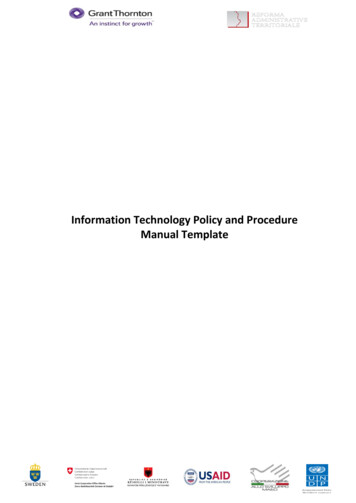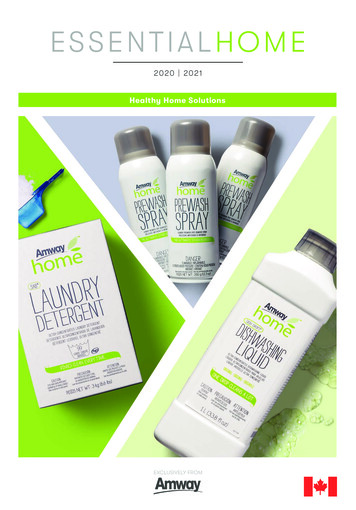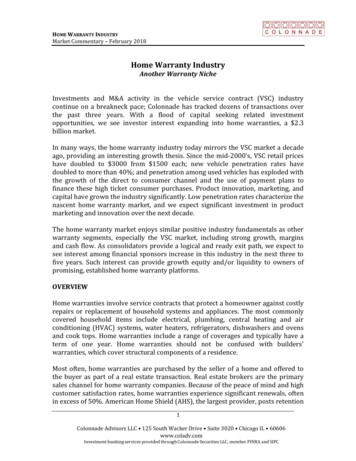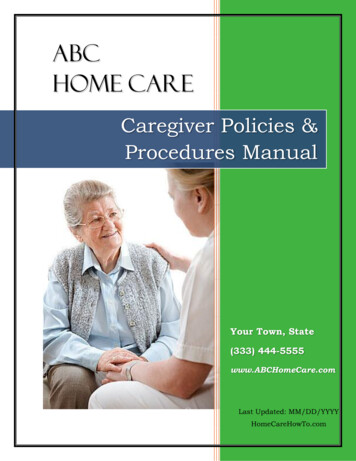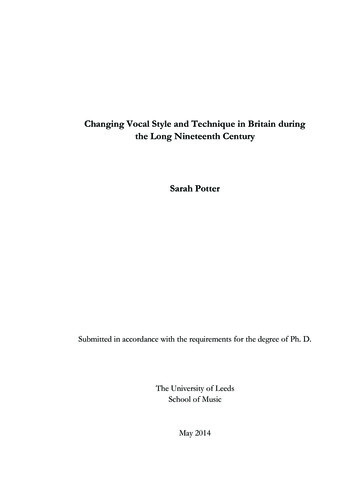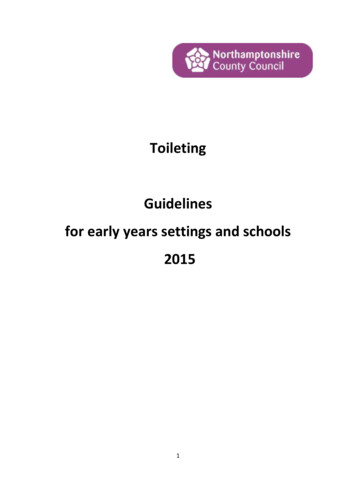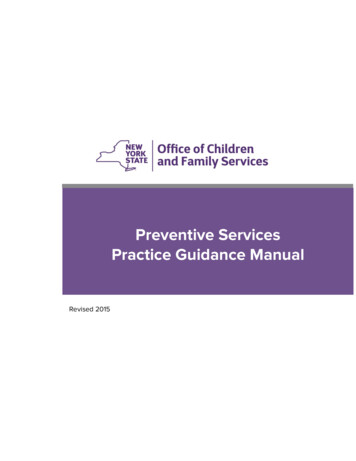
Transcription
Preventive ServicesPractice Guidance ManualRevised 2015
This document is provided under a contractual agreement between theNew York State Office of Children and Family ServicesDivision of AdministrationBureau of Training and DevelopmentandWelfare Research, Inc. (WRI)AcknowledgementThis material was developed by WRI under a training and administrative servicesagreement with the New York State Office of Children and Family Services.DisclaimerWhile every effort has been made to provide accurate and complete information, theOffice of Children and Family Services and the State of New York assume noresponsibility for any errors or omissions in the information provided herein and make norepresentations or warranties about the suitability of the information contained here forany purpose. All information and documents are provided “as is,” without a warranty ofany kind. Copyright 2015 by the New York State Office of Children and Family Services
Table of ContentsChapter 1: What are Preventive Services? . 1-1Preventive services and child welfare .1-1Mandated Preventive Services . 1-2Mandated-only preventive services.1-3Community Optional Preventive Services (COPS). 1-5Nondiscrimination . 1-6Reasonable efforts . 1-6Legal requirements. 1-6Preventive services as reasonable efforts . 1-7Chapter 2: Eligibility for Preventive Services .2-1Mandated preventive services . 2-1Eligibility criteria. 2-2Mandated-only preventive services . 2-5Preventive housing services . 2-5Respite care and services for families . 2-7Chapter 3: Persons in Need of Supervision (PINS) and Juvenile Delinquents (JDs) .3-1Persons in Need of Supervision (PINS). 3-1PINS diversion services .3-2Filing the PINS petition .3-3Court hearings .3-3Juvenile Delinquents . 3-4JD proceedings.3-4Sharing information . 3-6Case management . 3-6Documentation . 3-7Chapter 4: The Preventive Services Team .4-1Case manager . 4-1Case planner . 4-2Caseworker . 4-3
Other service program personnel . 4-4Foster care . 4-4Disrupted and dissolved adoptions . 4-5Child Protective Services . 4-6Family Court . 4-7Court orders for preventive services . 4-8Opening a preventive services case in CONNECTIONS . 4-8Chapter 5: Culturally Competent Services .5-1Importance of cultural competence in child welfare . 5-1Becoming culturally competent . 5-2Cultural competency skills for caseworkers. 5-3A more diverse child welfare workforce. 5-4Cultural and ethnic background . 5-5Tips for cross-cultural communication .5-5Race and racism . 5-6Gender identity and sexual orientation . 5-8Religion and spirituality . 5-9Chapter 6: First Meeting and Initial Assessment .6-1Forming a partnership . 6-1Preparing for the initial visit . 6-2During the initial visit . 6-4Special Considerations . 6-6Possible child abuse or maltreatment .6-6Hygiene and cleanliness .6-6Domestic violence . 6-7Interviewing adolescents . 6-7Absent family . 6-7Families that don’t follow through. 6-7Indications of child trafficking. 6-8Incarcerated parents . 6-8
The Initial Family Assessment and Service Plan . 6-8Family assessment . 6-9Service Plan . 6-9Preventive services standards . 6-10Chapter 7: Family Assessment: Safety and Risk . 7-1Safety Assessment . 7-1Non-CPS safety issues. 7-2Safety factors . 7-2Applying the safety criteria. 7-7Safety decision . 7-8Safety Plan . 7-9Controlling interventions . 7-10Documenting the safety assessment . 7-11Assessing risk of abuse/maltreatment . 7-11Risk Assessment Profile . 7-11The RAP family unit. 7-12Risk elements . 7-13Identification of abuse and/or maltreatment. 7-14Child maltreatment . 7-15Child abuse . 7-16Chapter 8: Family Assessment: Strengths and Needs .8-1Family Scales . 8-2Child Scales . 8-2Parent/Caretaker Scales . 8-2Underlying conditions: Community and culture .8-3Underlying conditions: Heredity and toxins.8-3Underlying conditions: Poverty .8-4Contributing factors: Mental illness.8-4Contributing factors: Traumatic experiences . 8-6Contributing factors: Incarcerated parents. 8-6Contributing factors: Developmental disabilities . 8-7Chapter 9: Casework Contacts & Family Team Meetings .9-1The Family Assessment and Service Plan (FASP) . 9-1
Goals and timelines.9-2Casework contacts . 9-3Who can make a casework contact? . 9-3Frequency and location of casework contacts . 9-4Documenting casework contacts .9-5Families receiving other services . 9-6Family team meetings . 9-6Preparing for the meeting . 9-7Format of the meeting . 9-7Special considerations . 9-8Cross-cultural issues . 9-8Domestic violence . 9-8Confidentiality . 9-8Advocates Preventive Only (ADVPO) cases . 9-10Outside agencies providing services . 9-10Probation Services . 9-10Law enforcement . 9-11HIV-related information . 9-11Written consent . 9-11Chapter 10: Reassessment FASP . 10-1The process of change. 10-1Reassessment FASP . 10-1Safety Assessment . 10-1Family update . 10-2Case update . 10-2Legal activity . 10-2Family strengths, needs, and risks. 10-2Risk Assessment Profile . 10-3Analysis. 10-3Service Plan Review . 10-3Programmatic eligibility. 10-4Plan Amendments . 10-4Recertification of mandated preventive services . 10-4
Child in foster care . 10-5Child in designated emergency foster family boarding home . 10-5Preventive Housing Services . 10-5Chapter 11: Closing the Case . 11-1Progress toward Service Plan goals . 11-1Development of family behaviors and skills . 11-1Access to support and resources . 11-2Preparing the family . 11-2Required case closings . 11-2Termination of Preventive Housing Services . 11-3Conferences and fair hearings . 11-3Closing a case in CONNECTIONS . 11-4Appendices
Chapter 1What are Preventive Services?Page 1-1Chapter 1What are Preventive Services?Preventive services strengthen families: they help parents and caregivers provide an environmentwhere children can thrive. Like preventive health care, these services address early symptoms of familyproblems that, if left untreated, may result in a breakdown of the family unit.According to New York State Social Services Law (SSL §409), preventive services are supportive andrehabilitative services that are provided to children and their families for the purpose of: Averting an impairment or disruption of a family which will or could result in the placement of achild in foster care; Enabling a child who has been placed in foster care to return to his family at an earlier time thanwould otherwise be possible; or Reducing the likelihood that a child who has been discharged from foster care would return tosuch care.Generally, preventive services are provided to families with children under the age of 18, because onlychildren under 18 may be at risk of placement into foster care. There are two significant exceptions: Preventive housing services may be provided to a youth with the goal of discharge to anotherplanned living arrangement with a permanency resource, who is to be discharged from fostercare prior to his/her 18th birthday, or who will be placed in trial discharge status after his/her 18 thbirthday. In these cases, services end when the youth reaches age 21. Preventive services must be provided to a youth who requests to re-enter foster care whensuch services may prevent the youth returning to care. Former foster care youth may bereturned to foster care if they file a motion in court within 24 months of the date of their firstfinal discharge. Preventive service providers should evaluate youth before they reach the 24month mark to determine the effectiveness of Preventive Services in meeting their needs[11-OCFS-ADM-02].Preventive services may be provided directly by the local social services district (LDSS) or by anotheragency that is authorized and approved to provide a program of preventive services [NYCRR 423.2(a)].Preventive services and child welfareAs child welfare professionals, we believe that every child deserves to be protected from harm in astable, nurturing environment. Our goals for all children are safety, permanency, and well-being.Preventive services play a crucial role in achieving these goals, as they are designed to improve thewell-being of the family as a whole and the safety and security of the children in those families.In New York State, families usually come into the child welfare system because a report of child abuse ormaltreatment has been made. According to national statistics, about one third of the cases investigated byCPS are substantiated. Of these cases, more than half will be eligible for preventive services because thechildren are at risk for placement into foster care. Even when abuse or maltreatment is not substantiated,OCFS Preventive Services Practice Guidance Manual September 2015
Page 1-2What are Preventive Services?Chapter 130% of cases will involve children who are at risk for placement into foster care.1 Clearly, culturally andlinguistically competent preventive services can have a significant impact on stopping a downward spiral.A child or family may be eligible for either mandated or non-mandated preventive services, dependingon the level of risk for a child’s placement into foster care. A child or family is eligible for mandatedpreventive services when the risk of placement is immediate or imminent.Non-mandated preventive services are provided at the discretion of the local social servicesdepartment when children are at risk of placement into foster care but that risk is not immediate orimminent. The case manager must determine that the risk will be reduced if the family receives one ormore of the preventive services available to them.When children live in particular communities or have circumstances that put them at elevated risk ofplacement into foster care, they and their families can be referred for Community Optional PreventiveServices.Mandated Preventive ServicesNew York State Social Services Law [SSL 409-a(1)] addresses when preventive services are mandated.As set forth in OCFS regulation 18 NYCRR 423.3, the eligibility criteria for mandated preventive servicesare defined in OCFS regulation 18 NYCRR 430.9. To be eligible for mandated preventive services, thecase must satisfy these eligibility criteria. These standards are detailed in Chapter 2 of this manual.When a child and his/her family meet the eligibility requirements for mandated preventive services, theLDSS or voluntary agency determines which service is available, appropriate and necessary to meet theneeds of the child or family. OCFS regulation 18 NYCRR 423.4(d)(1) requires that each LDSS havespecified core services available. Core services include: Day care Homemaker services Parent training or parent aide Clinical services Transportation Respite Care and Services for Families when a parent, legal guardian, caretaker, or child hasHIV/AIDS or an HIV-related illness Emergency services (24-hour access) Preventive housing servicesPreventive services must be provided to eligible families, as determined by LDSS or voluntary agency,regardless of income, but only when a family agrees to accept them. Families may refuse to acceptservices, but if there is a risk to children’s health or safety, further action by Child Protective Servicesmay be needed.Preventive services can be provided directly by LDSS staff or by a contracted preventive servicesagency. The agency does not need to be located within the district: the key is the availability andU.S. Department of Health and Human Services (2008), Child Maltreatment 2006, Washington: U.S. GovernmentPrinting Office1OCFS Preventive Services Practice Guidance Manual September 2015
Chapter 1What are Preventive Services?Page 1-3accessibility of the service, should it be needed. The local district may improve accessibility byproviding transportation for family members.Preventive services funds also can be used for outreach activities designed to publicize the existenceand availability of preventive services for parents, caretakers, and children who meet the criteria for theprovision of preventive services and to advise such parents, caretakers and children of the availabilityof such services to meet their needs, alleviate the cause or condition that creates the risk of foster careplacement, and to assist the family to stay together. These outreach activities are for the purpose ofidentifying parent service needs and child services needs [18 NYCRR 432.2(b)(18)].Mandated-only preventive servicesThree services may be provided only in cases that are eligible for mandated preventive services: Intensive, Home-Based Family Preservation Services Preventive Housing Services Respite Care and Services for FamiliesEach of these services has requirements and specifications in addition to the eligibility standards setfor mandated preventive services. They cannot be provided as non-mandated preventive services.Intensive, Home-Based Family Preservation ServicesAs defined in OCFS regulation [18 NYCRR 423.2(17)(i)], these services are part of a direct interventiondesigned to restore or stabilize family functioning, primarily through teaching and role modeling, to giveparents the skills to resolve conflict and seek out help.Intensive family preservation services are provided over a brief period of time. The initial period is up to30 days, with the possibility of a 30-day extension when necessary to maintain the progress alreadyachieved or to avoid the foster care placement of children. The caseworker must be available to thefamily on a 24/7 basis in order to establish a relationship between the caseworker and the family. Atleast half of these services must be provided in the family’s home. While state law[SSL 409-a(5)(e)(ii)] requires that a caseworker be assigned no more than four families at a time, theoptimum caseload for intensive family preservation services is two or three families.On behalf of the family, the caseworker providing intensive services also may arrange for: Housing assistance Child care Job training Education Emergency cash grants Basic supportPreventive Housing ServicesA child or family may be eligible for preventive housing services when the LDSS determines that:OCFS Preventive Services Practice Guidance Manual September 2015
Page 1-4What are Preventive Services?Chapter 1 Inadequate housing makes it difficult or impossible for parents or caretakers to meet the basicneeds of the family, which, along with a service need other than adequate housing, places thechild at imminent risk for placement in foster care Inadequate housing is the primary factor preventing the discharge of a child from foster careand returning home Inadequate housing is preventing a child from being discharged to a planned livingarrangement with a permanency resource Inadequate housing is preventing a youth from being discharged to independent livingPreventive housing services are provided when a family needs financial assistance to afford or retainappropriate housing in order to care for a child. This may include providing more space to accommodate thechild or upgrading the condition of a house or apartment so the child can live there safely.According to Social Services Law [SSL 409-a], preventive housing services include cash grants in theform of rent subsidies, including payment of rent arrears, or any other assistance necessary to obtainadequate housing. In addition to rent subsidies, preventive housing services may also include: Rental or mortgage arrears when they place the family at risk of losing its home Security deposits necessary to obtain or retain a house or apartment Finder’s or broker’s fees incidental to locating adequate housing Household moving expenses to allow a move from inadequate to adequate housing Exterminator fees, as necessary to obtain or retain adequate housing Essential repairs of conditions that create a substantial health or safety riskThe preventive housing services rent subsidy is to be paid in addition to any other payments or benefitsreceived by the family. Payments for prev
Page 1-2 What are Preventive Services? Chapter 1 OCFS Preventive Services Practice Guidance Manual September 2015 30% of cases will involve children who are at risk for placement into foster care.1 Clearly, culturally and linguistically competent preventive services can


